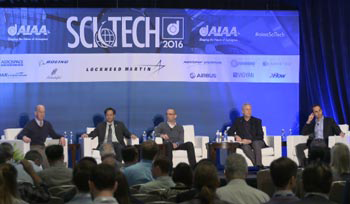3-D Printing Creates Opportunities in Aerospace Written 6 January 2016
Panelists: Greg Arend, development leader, Additive Manufacturing, United Launch Alliance; Robert Yancey, vice president, Aerospace and Composites, Altai Engineering Inc.; Franck Mouriaux, general manager, RUAG Schweiz Structures, AG, RUAG Space; Chauncey Wu, Structural Mechanics and Concepts Branch, NASA’s Langley Research Center; Jason Dunn, chief technology officer and co-founder, Made In Space Inc.
by Hannah Godofsky, AIAA Communications

Additive manufacturing, or 3-D printing, offers many opportunities for engineers and product designers, but there are some constraints. Several representatives from the space sector spoke on these pros and cons Jan. 6 at the 2016 AIAA Science and Technology Forum and Exposition in San Diego.
Robert Yancey, vice president of Aerospace and Composites with Altair Engineering, said one reason additive manufacturing has caught on is that parts can be made without the tooling, which can be more expensive than the parts. He cited barriers that include surface quality, heat stresses, size, holes, building sizes, support structures, overhangs and cost.
Chauncey Wu, a researcher with NASA’s Langley Research Center, said his agency keeps 3-D printing more efficient by using two print heads so that one can run while the other is cleaned or maintained.
“The industry uses this capability to keep the machine operating as much as possible,” he said.
Franck Mouriaux, a general manager with RUAG Space, spoke about broader changes that may come to space technology as a result of 3-D printing.
“I think thanks to additive manufacturing, we will be able to develop new kinds of products with structures and electronics integrated,” he said, adding there may be a possibility for “more bionic designs and less ‘extrude and rotate.’”
Some of the challenges in introducing additive manufacturing techniques to an existing product line include cost constraints and difficulties in persuading engineers to shift from metal to composite materials, said Greg Arend, a development leader with United Launch Alliance.
The gains in efficiency are worth it, he said, as every ounce of weight costs a lot to send to space, and composite materials are much lighter than metal.
“The challenge I’ve issued to my designers is, give me free parts,” Arend said. “Or better than that, give me less than free parts. Give me money back.”
Jason Dunn, chief technology officer and co-founder of Made in Space, has experience with 3-D printing on the international space station.
“We launched this 3-D printer to the space station, and [Barry "Butch" Wilmore] was the commander when it was received. Butch became the first person ever to manufacture real items off of planet Earth,” he said.
